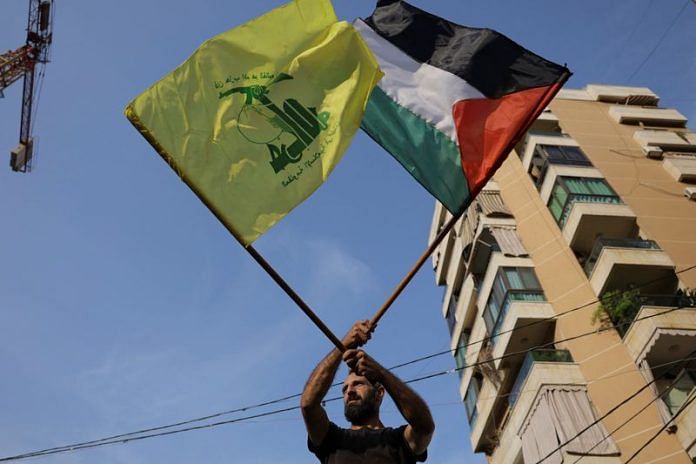(Reuters) – Israeli forces and Lebanon’s Hezbollah have engaged in increasingly heavy exchanges of cross-border fire since early October, in the biggest escalation on the frontier since the Iran-backed group and Israel fought a war in 2006.
Hezbollah, one of the most heavily-armed, non-state groups in the world, is the most formidable of Iran’s allies in its “Axis of Resistance”, which includes Palestinian Islamist group Hamas, Iraqi militias and others.
Hezbollah leader Sayyed Hassan Nasrallah has said the group has 100,000 fighters.
Here is an overview of some of Hezbollah’s most significant weapons, based on Hezbollah statements, security sources, weapons experts and academic reports.
THE OVERALL ARSENAL AND HOW IT HAS GROWN
Hezbollah’s military strength is underpinned by a vast arsenal of rockets. Experts believe the Shi’ite Islamist group may possess more than 100,000 rockets today. Hezbollah says it has rockets that can hit all areas of Israel.
Many of the rockets are unguided, but it also has precision missiles, drones and anti-tank, anti-aircraft and anti-ship missiles.
Hezbollah’s main supporter and weapons supplier is Iran. Experts say the Islamic Republic sends arms to the group by land via Iraq and Syria, both Middle East countries where Iran has close ties and influence. Many of the group’s weapons are Iranian, Russian or Chinese models.
LAND-ATTACK ROCKETS AND MISSILES
Unguided rockets comprised the bulk of Hezbollah’s missile arsenal in the last war with Israel in 2006, when the group fired about 4,000 of them into Israel – mostly Russian-made Katyusha-style missiles with a range of up to 30 km (19 miles).
Hezbollah has Iranian models, such as Raad (Arabic for Thunder), Fajr (Dawn) and Zilzal (Earthquake) rockets, which have a more powerful payload and longer range than Katyushas.
Nasrallah has said the biggest change in the group’s arsenal since 2006 is the expansion of its precision guidance systems. Last year, he said Hezbollah had the ability within Lebanon to retrofit thousands of rockets with guidance systems to make them precision missiles.
This puts more Israeli territory in Hezbollah’s range, and experts say it could enable the group to strike more specific targets such as critical infrastructure and military sites.
Hinting at the damage it could now do, Nasrallah in 2016 made a veiled threat that Hezbollah could hit ammonia storage tanks in the northern Israeli port city of Haifa, saying the result would be “like a nuclear bomb”.
ANTI-TANK MISSILES
Hezbollah used guided anti-tank missiles extensively in the 2006 war. It has deployed guided rockets again in the latest round of fighting, hitting Israeli positions at the border.
Israel has said during that the latest flare-up that it has responded to anti-tank missiles.
Hezbollah has posted videos of what it says are direct hits on Israeli tanks and other military vehicles since Oct. 7. Videos also show guided strikes on military installations on the Israeli side of the country’s northern border with Lebanon.
ANTI-AIRCRAFT MISSILES
Hezbollah said on Oct. 29 it had shot down an Israeli drone over south Lebanon with a surface-to-air missile, the first time it has announced such an incident.
There was no comment from Israel about that claim, but a day earlier the Israeli military said it had thwarted a surface-to-air missile fired towards an Israeli unmanned aerial vehicle (UAV), and that the military had responded by striking where the missile was fired from. It did not give a location.
Experts have previously said Hezbollah has shoulder-held anti-air missiles in its arsenal.
ANTI-SHIP MISSILES
Hezbollah first proved it had anti-ship missiles in 2006, when it hit an Israeli warship 16 km (10 miles) off the coast, killing four Israeli personnel and damaging the vessel.
Hezbollah has since broadcast videos that it says show more of the same weapons that were used in 2006. It has said future targets could include Israel’s offshore gas infrastructure.
DRONES
Hezbollah’s drones, including what it says are the locally-assembled Ayoub and Mersad models, are mostly used for reconnaissance, although they can carry a small ordnance payload.
Experts say the drones, which can be produced cheaply and in large quantities, could be aimed at draining Israel’s Iron Dome air defence system.
Israel accused Iran in September of building an airstrip in south Lebanon that could be used to launch attacks. A non-Israeli source with knowledge of the site said it could accommodate large, potentially weaponised drones, based on an Iranian design.
(Reporting by Maya Gebeily, Timour Azhari and Tom Perry; Editing by Edmund Blair and Mark Heinrich)
Disclaimer: This report is auto generated from the Reuters news service. ThePrint holds no responsibilty for its content.



